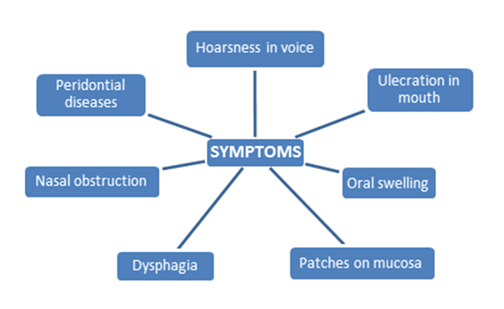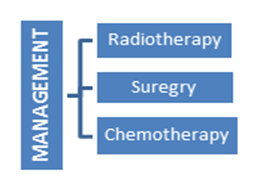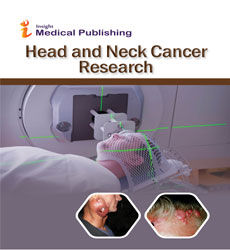The Sixth Most Common Cancer around the Globe, Head and Neck Squamous Cell Carcinoma (HNSCC): A Short Review
Kusuma Thrinadh*
DOI10.36648/2572-2107.21.6.36
Kusuma Thrinadh*
Department of Oncology, The University of Texas MD Anderson Cancer Center, USA
- *Corresponding Author:
- Kusuma Thrinadh Department of Oncology, The University of Texas MD Anderson Cancer Center, USA, E-mail: kusumathrinadh95@gmail.com
Received date: July 21, 2021; Accepted date: August 04, 2021; Published date: August 11, 2021
Citation: Kusuma T (2021) The Sixth Most Common Cancer around the Globe, Head and Neck Squamous Cell Carcinoma (HNSCC): A Short Review. Head Neck Cancer Res. Vol.6 No.4.36
Abstract
In head and neck cancers, the most common causative form of the cancers I squamous cell carcinoma. These types of cancers in head and neck region are named as head and neck squamous cell carcinomas (HNSCC) and are caused by few risk factors such as smoking tobacco, alcohol intake and human papilloma virus (HPV) infection. The advancements in the cancer treatment are helping not only in the treatment also in the screening of the cancers. Though there are the treatments available, there are situations where the patients with HNSCC suffer with the reoccurrences and also sometimes patients drive with the poor survival. In this review, causatives, symptoms, the latest advancements for treating the HNSCC patients and screening procedures are discussed in this short review which would give a path for the researchers to continue their studies.
In head and neck cancers, the most common causative form of the cancers I squamous cell carcinoma. These types of cancers in head and neck region are named as head and neck squamous cell carcinomas (HNSCC) and are caused by few risk factors such as smoking tobacco, alcohol intake and human papilloma virus (HPV) infection. The advancements in the cancer treatment are helping not only in the treatment also in the screening of the cancers. Though there are the treatments available, there are situations where the patients with HNSCC suffer with the reoccurrences and also sometimes patients drive with the poor survival. In this review, causatives, symptoms, the latest advancements for treating the HNSCC patients and screening procedures are discussed in this short review which would give a path for the researchers to continue their studies.
Keywords
Head and Neck Squamous Cell Carcinoma (HNSCC); Human Papilloma Virus (HPV); Immune determinantsv
Introduction
Cancers are been evolving since decades, where the number of types of cancers are increasing day by day, rather than the medication for treating it. Cancers is a continuous process that originates due to the genetic alterations. When compared with all the cancers, head and neck cancers ranks 8th place globally. The cancer that is caused in head and neck region by the squamous cells are called to be as the head and neck squamous cell carcinomas. These are abbreviated with HNSCC. These cancers are developed or raised from the mucosal epithelium of the mouth i.e., oral cavity [1]. The most common cancerous cells in the head and neck region are from pharynx, larynx. Here, the cell becomes cancerous or gets affected with the unhealthy habits or lifestyles such as over taking of the alcohol, exposure to the tobacco smoking or both in parallel way. Mostly, the tumors that are seen in the oro-pharyngeal cavity or oropharynx, is caused by HPV-16 with more extent and HPV-18 with lesser extent i.e., the types of human papilloma virus (HPV). As most of the cancer causing HPV infections are been covered under the FDA vaccinations, the burden can be reduced and therefore these can a chance for preventing the cancer that are correlated to the HPV carcinogens. About 8% of the United States is affected by HNSCC, about 15% in the United Kingdom [2]. It is generally a disease which can be treated and cured but only in terms of the early stages. Combination treatments are preferred, such that, it could help in preventing the organ’s loss and organ’s dysfunction. The HNSCC’s incidences are seen overall in a number of 50 people in every 100 000 population.
Causatives for HNSCC’s
As we know, it is the food that acts as the medicine for the body. But, with the culture and the eating ways, irregular eating patterns and different dishes with more spice etc., are the reasons for causing all forms of cancers. But, in case of the HNSCC’s, the important causatives are tobacco, alcohol, betel and some narcotics. By taking these in a regular pattern, the inner layers of the throat and slowly start affecting the cells. Before, smoking and drinking were habituated in terms of stress to get relief, but these days, it has become a fashion, irrespective of the age and gender. All age groups and genders are highly participating in taking these on daily basis. Taking rarely is different from taking daily, as the inner linings are sensitive, these may lead to the slow dysfunction when compared to that of the normal or healthy functioning [3,4].
Symptoms of HNSCC’s
The symptoms when a person is affected by HNSCC are pain in throat and ear, change in voice where hoarseness is observed approximately for 3 to 6 weeks and sometimes persist for more than 6 weeks. While swallowing there will be difficulty and even sense pain in the ear. In some patients, there are some silent causes such as, under the tongue, there might be the presence of the metastases. When little change is observed, there must be screening or else, these are notorious and may last for long term period. In general symptoms that are mentioned below in the following Figure 1.
Countries that got affected by the HNSCC
The countries that are being affected by the HNSCC are mentioned in the following Figure 1. Almost many countries are affected by the HNSCC, but few countries have major fall into the risk of squamous carcinoma for head and neck, mostly because of their un-healthy habits [5]. Generally, the noticeable countries are, India, United Kingdom, United States, France, Hong Kong etc. (Figure 2).
In ancient times, these are not even traceable, but now with the advancement in technologies, the lifestyle patterns have been changed and are taking more chances for causing the risk of many diseases and some are life threatening like cancers.
Role of immune system in developing HNSCC
Cancer The immune system though plays a crucial role in the development as well as progression of HNSCC. The immune system acts as surveillance for preventing the cell to become cancerous by its natural phenomena. Also, there are studies that ended up saying that the immune system helps in preventing the unusual cell growth but, when the growth is vigorous. Therefore, the system tends to lose the ability to eradicate the cancerous cells. The deep study or research on the immune system helps for accelerating the immunotherapy specifically as it would be a promising approach with less toxic effects when compared to other therapies. Few immune therapies are under the clinical studies [6]. The immune system has the memory to identify between the self and non-self-pathogens. The innate immune system is totally based on the defense mechanisms that would be activated after they come into contact with the pathogens. Whereas, the adaptive immunity depends on the gene rearrangements of the somatic cell in order to produce the antigens that multiply the receptors which discriminate between closely related molecules.
Screening Procedures
Screening of any disease before getting worse is better, rather than allowing it become more severe. So, screening plays an important or crucial role in detecting its mode of occurrence, stage at which it is growing and what type of treatment is to be started. Even these screenings are to be made or generally made for detecting how extent the medicine is working or how extent the medicine is minimizing the growth of the infected organ. There are some screening procedures in specific for the cancers [7,8].
Imaging of head and neck
Imaging helps in assessing the histologically driven tumors, which would be able to detect the presence of the enlarged nodes i.e., enlarged lymph nodes. Once the imaging is done, the staging is performed for the detection, where the maximum part of the cancers are detected about 30% to 45% is detected.
Computed tomography: It is an advanced head and neck malignancy, which is available easily.
Magnetic resonance imaging: It is one of the tools preferred for finding out the primary tumor. This magnetic resonance helps in assessing the bone, cartilage, perineural as well as perivascular invasion.
Positron emission tomography: It is one of the screening techniques, which detects the diseases that have the tendency to reoccur.
Combination screening: By neck ultrasonography and fine needle aspiration improves the specificity of the staging of the cervical lymph nodes and helps in choosing an appropriate mode of treatment.
Staging
The major determinant of the HNSCC’s prognosis is, staging. The staging helps in detecting the etiology, the characteristics of the cell i.e., molecularly. Before, there used to be the classification in staging like the disease’s anatomy, the causative sub site’s status etc., and now the root cause can also be detected by HPV status using this staging.
Management of HNSCC
Traditionally, only surgery is the only way for ending up the cancer spread and save life. The squamous cell carcinoma of the head and neck plays a crucial role as there must be the consideration with respect to the primary site of occurrence and cervical lymph nodes. In management, the radiotherapy as well as surgery gives a good and long term relief. Choosing the radiotherapy or the surgery again makes the physician into dilemma as the, both of the management tools are crucial. Based on the age, gender, stage of the disease and the severity, the radiotherapy or chemotherapy or the surgery is decided [9-11]. Many studies revealed that, after radiotherapy, the functioning is better than that of the surgery. When there is an urge to get relieve fast, surgery is opted, as radiotherapy requires many weeks of sittings (Figure 3).
Preventive Measures
The changing patterns in the lifestyle as well as habits, there would be less prone to the disease. There are many studies even revealed that there are chances for reducing the cancer. The early screening at time of any difficulty also is helpful without any major damage. HPV Vaccination which is FDA approved also helps in preventing the disease.
Conclusion
As we know that cancers are life threatening and leaving bitterness in the people, it would be better to withhold certain good lifestyle and habits for preventing before causing. Also, the role of immune system and its contribution as a promising approach to treat HNSCC were discussed. Multiple therapies may not affect the organ and also by improving quality of life by quitting the intake of alcohol, smoking, healthy food etc., there might be chances for curing. Though there are advances in the technology, drug development, there are many approaches to improve the outcomes for the patients with HNSCC.
References
- Gillison ML (2019) Radiotherapy plus cetuximab or cisplatin in human papillomavirus-positive oropharyngeal cancer (NRG Oncology RTOG 1016): A randomised, multicentre, non-inferiority trial. Lancet 393: 40–50.
- Mehanna H (2019) Radiotherapy plus cisplatin or cetuximab in low-risk human papillomavirus-positive oropharyngeal cancer (De-ESCALaTE HPV): An open-label randomised controlled phase 3 trial. Lancet 393: 51–60
- Ferlay J (2019) Estimating the global cancer incidence and mortality in 2018: GLOBOCAN sources and methods. Int J Cancer 144: 1941–1953.
- Jiang H (2019) Can public health policies on alcohol and tobacco reduce a cancer epidemic? Australia’s experience. BMC Med 17: 213.
- International Agency for Research on Cancer. List of Classifications by cancer sites with sufficient or limited evidence in humans, Vol 1 to 127. IARC Monographs On The Identification Of Carcinogenic Hazards To Humans. IARC.
- Yu SS, Cirillo N (2020) The molecular markers of cancer stem cells in head and neck tumors. J Cell Physiol 235: 65–73.
- De la Oliva J, Larque AB, Marti C (2019) Oral premalignant lesions of smokers and non-smokers show similar carcinogenic pathways and outcomes. A clinicopathological and molecular comparative analysis. J Oral Pathol Med 50(3):280-286.
- Nisha KJ, Janam P, Harshakumar K (2019) Identification of a novel salivary biomarker miR-143-3p for periodontal diagnosis: A proof of concept study. J Periodontol 90:1149-59.
- Irani S, Shokri G (2019) The Role of miR-143, miR-145, and miR- 590 in Expression Levels of CD44 and vascular endothelial cadherin in oral squamous cell carcinoma. Middle East J Cancer 10:194-204.
- Chang C, Geng F, Shi X (2019) The prevalence rate of periodontal pathogens and its association with oral squamous cell carcinoma. Appl Microbiol Biotechnol 103:1393-404.
- Wozny AS (2019) Ros production and distribution: A new paradigm to explain the differential effects of x-ray and carbon ion irradiation on cancer stem cell migration and invasion 11(4): 468.
Open Access Journals
- Aquaculture & Veterinary Science
- Chemistry & Chemical Sciences
- Clinical Sciences
- Engineering
- General Science
- Genetics & Molecular Biology
- Health Care & Nursing
- Immunology & Microbiology
- Materials Science
- Mathematics & Physics
- Medical Sciences
- Neurology & Psychiatry
- Oncology & Cancer Science
- Pharmaceutical Sciences



